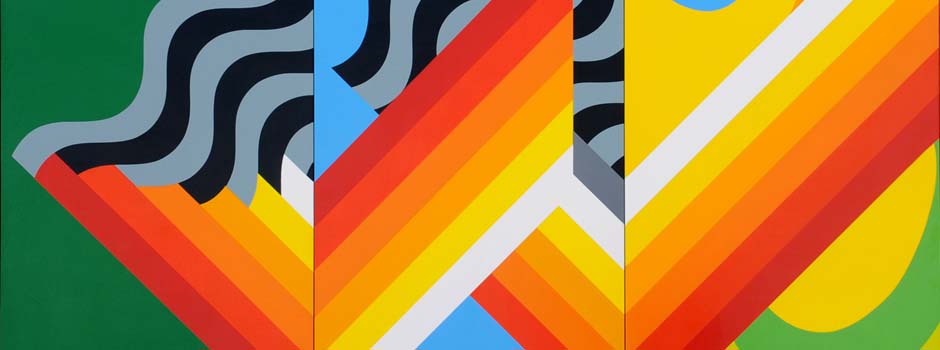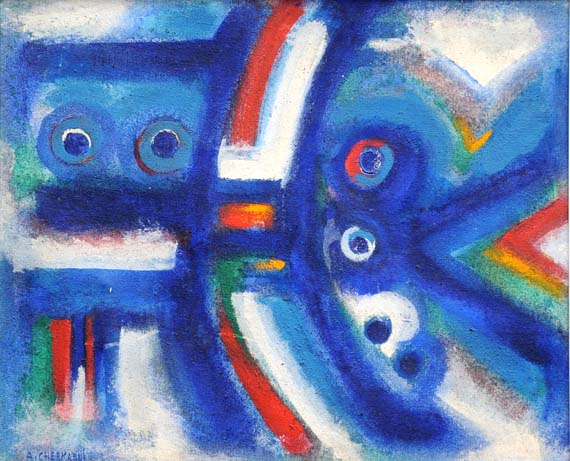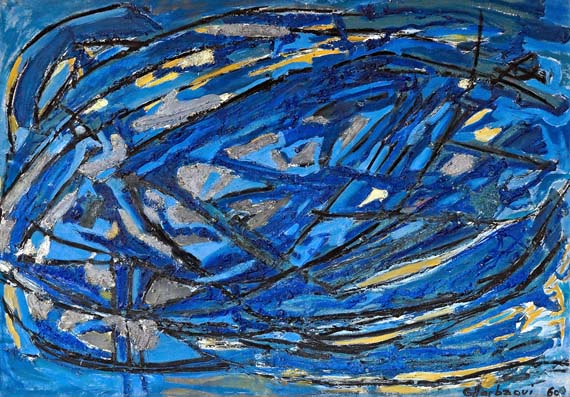
ART MOROCCO: Mohammed Melehi Ahmed Cherkaoui and Jilali Gharbaoui
Mar 06, 2012 Exhibition
Art Morocco, held at Meem Gallery this spring, presents the rare opportunity to view the work of Moroccan modern masters Mohammed Melehi, Ahmed Cherkaoui and Jilali Gharbaoui. Pioneers of modern abstract painting in Morocco, their work demonstrates how, following the country’s independence in 1956, artists created an aesthetic dialogue between their cultural heritage and the impact of colonialism on North African artistic culture. Having studied abroad during the late 1950s (in Europe and the US), the three artists’ work formally adheres to modern Western artistic techniques but simultaneously references traditional Moroccan arts and crafts, signs and symbols. In 1959, Melehi and Gharbaoui exhibited their work at the Première Biennale des Jeunes in Paris, introducing the international art world to contemporary Moroccan art. The artists, along with Cherkaoui, also participated in the second installment of the Biennale in 1961. This exhibition is the first show to display the work of the three artists in the United Arab Emirates.
Image above: Mohammed Melehi, Zig Zag (1984) Lacquer on wood, 150 _ 150 cm, Triptych / Image courtesy of Meem Gallery
Mohammed Melehi (b. 1936, Asilah) graduated from the École des Beaux-Arts, Tétouan, Morocco, in 1955. He continued his studies abroad, learning fine art in Seville and Madrid, sculpture in Rome, and engraving in Paris. In the early sixties, he travelled to the United States, where he studied at Columbia University (with a scholarship from the Rockefeller Foundation) for two years before returning to Morocco in 1964. It was during this time that Melehi began to explore his cultural heritage as a primary source of inspiration and started using a bolder, more brilliant colour palette.
In 1969, Melehi organised the first open-air group exhibition, held in Marrakech medina’s Jamaa el-Fna Square, in Morocco. Eliciting much acclaim from the public and art critics, this exhibition radicalized the country’s contemporary art scene.
Melehi was Professor of painting, sculpture and photography at the Casablanca School of Fine Arts from 1964-69. In 1978, Melehi and Mohamed Benaissa created the Al Mouhit Cultural Association, a non-political organization with purely cultural objectives. The result of this venture is the Asilah Cultural Moussem, an annual festival held every summer. A highlight of the festival is the mural painting event, first held in April 1978, a project which has revitalized the formerly dilapidated appearance of the artist’s birthplace. Asilah is now celebrated for its vividly coloured murals, many of which have been created by Melehi.
Melehi is also President of the Moroccan Association of Plastic Arts, and was the Director of Arts for the Ministry of Culture, from 1985-92, and was also the cultural consultant to the Ministry of Foreign Affairs and Co-operations, from 1999-2002. He has held numerous solo exhibitions including a retrospective at the Institut du Monde Arabe, Paris, 1995, and the Bronx Museum of the Arts, New York, 1984. He has participated in group shows in Casablanca, Tangiers, Rabat, Marrakech, Baghdad, Algiers, London, Paris, Rome, Zurich, New York, Chicago and Montreal. His work is held in international museum collections such as Centre Georges Pompidou, Beaubourg, Paris, Institut du Monde Arabe, Paris, MOMA, New York, and Mathaf: Arab Museum of Modern Art in Doha.
 Ahmed Cherkaoui / Le Bleu Ange (1965) Oil on canvas, 65 _ 120 cm, Collection Groupe Attijariwafa Bank / Image courtesy of Meem Gallery
Ahmed Cherkaoui / Le Bleu Ange (1965) Oil on canvas, 65 _ 120 cm, Collection Groupe Attijariwafa Bank / Image courtesy of Meem Gallery
Ahmed Cherkaoui (b. 1934-1967, Boujad) developed an early interest in Arabic calligraphy while studying the Koran as a child. After attending secondary school in Casablanca, Cherkaoui travelled to Paris to study Graphic Design at the École des Beaux-Arts de Paris (1956-59), followed by a fine arts course held in Aujame’s studio at École Nationale Supérieure des Beaux Arts (1960). In 1961, he left Paris for Warsaw to study at the Fine Arts Academy for a year. That summer he returned to Morocco for a visit, a time when he started to gain a keener understanding of himself as an artist and placed greater focus on the study of signs and the importance of research as a basis for his work.
Settling in Paris, in 1962, Cherkaoui received a UNESCO grant to study Arabic calligraphy and Berber signs. In his paintings the artist did not replicate signs or letters found in his research but, rather, used such forms as a point of departure in his exploration of abstraction. The artist’s oeuvre reflects numerous other influences including Moroccan arts and crafts and European painting.
Cherkaoui’s career was cut short when he passed away suddenly in 1967 at the age of thirty-three. Since his death there have been many retrospective exhibitions of his work including Cherkaoui: La Passion du Signe, Institut du Monde Arabe (1996) and Hommage à Cherkaoui, Salon de Mai (1968). During his life he held solo exhibitions in Rabat, Casablanca, Tangiers, Paris, Warsaw,
Johannesburg and London. He also participated in numerous group show and biennales worldwide. His work is held in international collections including Mathaf: Arab Museum of Modern Art, Doha; Institut du Monde Arabe and Musée d’Art Moderne, Paris.
 Jilali Gharbaoui / Untitled (1960) Oil on canvas, 65 _ 92 cm, Collection Groupe Attijariwafa Bank / Image courtesy of Meem Gallery
Jilali Gharbaoui / Untitled (1960) Oil on canvas, 65 _ 92 cm, Collection Groupe Attijariwafa Bank / Image courtesy of Meem Gallery
Jilali Gharbaoui (b. 1930-71, Jorf El Maleh) started his artistic training at the Academy of Fine Arts, Fez (attending evening classes while working as a newsagent during the day). In 1952, he received a scholarship to study at the École Nationale Supérieure des Beaux-Arts in Paris. After graduating in 1956, he continued his studies in Fine Arts at Académie Julian, Paris. In 1958, he moved to Rome after receiving a fellowship from the Italian government. During his stay in Europe, Gharbaoui became interested in the work of the Impressionists, Dutch painting and German Expressionism, leading to his exploration of abstract painting.
Gharbaoui held his first solo exhibitions in Rabat and Casablanca in 1957, and held further one-man shows in Rome and Morocco until 1971. He also participated in numerous group exhibition and biennales in Rome, Paris, Casablanca and Madrid. In 1957 he was awarded first prize by the San Francisco Museum of Art. His work is held in international collections including Mathaf: Arab Museum of Modern Art, Doha; Fondation ONA, Casablanca; Fond Municipal d’Art Contemporain, Paris; and Musée de Grenoble.
His oeuvre is defined by his compositional studies of light and colour. Gharbaoui’s work is often interpreted in relation to his introverted and reflective personality, more specifically his tendency towards depression (Gharbaoui attempted suicide in 1955) and substance abuse, which lead to his untimely death in 1971. Regarded as one of the founders of modern abstract painting in Morocco, in 1980 a retrospective of his work was held at Galerie l’Oeil Noir, Rabat.
Comments
Add a comment